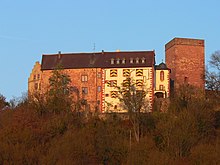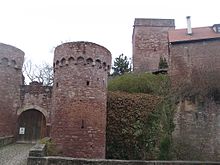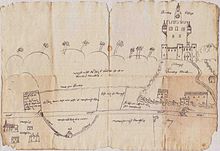Gamburg Castle
| Gamburg Castle | ||
|---|---|---|
| Alternative name (s): | Gamberg, Upper Castle, castrum Gamburg | |
| Creation time : | Middle of the 12th century | |
| Castle type : | Höhenburg, summit location | |
| Conservation status: | Receive | |
| Standing position : | Archbishops, counts, barons | |
| Construction: | Sandstone | |
| Place: | Gamburg | |
| Geographical location | 49 ° 41 '46 " N , 9 ° 36' 10.2" E | |
| Height: | 242.5 m above sea level NHN | |
|
|
||
The Gamburg ob der Tauber, today officially Gamburg Castle and Castle Park , also called Gamburg Castle , is a 12th-century castle on the summit in Gamburg , a district of the municipality of Werbach in the Main-Tauber district in Baden-Württemberg .
location
The Höhenburg complex is located directly above Gamburg on the 242.5 m high Schlossberg above the Tauber . The historical term Upper Castle was created to differentiate the rule of the Lower Castle Gamburg, which was separated from 1568/77 to 1806/07 . The castle has been privately owned and inhabited since 1546.
history
The castle was built in the middle of the 12th century by the archbishops of Mainz, first mentioned in 1157 as "castrum Gamburc" and at the same time, as a fiefdom from Archbishop Arnold von Selenhofen, it came into the possession of the noble free Beringer von Gamburg , who gave the archbishop the villula Brunnenbach , today's Schafhof near Bronnbach, left. The lords of Gamburg died out as early as 1219 and the castle was then occupied as an official residence by castle men . For 1292 and 1315 Rudolf von Wertheim was notarized as hereditary castle man. 1339 noble servant Ludwig von Rieneck was won as a castle man. In 1347 the castle was pledged to Henrich von Salza and his wife Gute, actually in exchange for the castle ( Dryburg Castle ) and the city of Salza , which he had given to the Archbishop of Mainz, Heinrich III, two years earlier . von Virneburg had sold. In 1358 a third share of the castle was pledged to the Lords of Grumbach and in 1359 to those of Stettenberg . Further lendings, partly from the free float around the Gamburg, follow.
In 1546, Eberhard Rüdt von Collenberg acquired the castle from the Archbishop of Mainz through an exchange. Thereafter, Dietrich von Hattstein (1568), Eberhard Brendel von Homburg (1570), the cousins Hartmut the Elder and the Middle von Kronberg (1590), Hartmut the Elder von Kronberg alone (1592), the lords (later barons) inherited the castle Dalberg (1606) and the barons (later imperial counts) von Ingelheim (1722). In 1936 the castle went to Count Emanuel von Westerholt-Gysenberg .
After the Second World War , displaced persons were housed here. In 1947, Count von Westerholt-Gysenberg rented parts of the castle to the Caritas Association ; The rural folk high school for North Baden was added as sub-tenants in 1949 and a special needs school for emigrants in 1957. The von Mallinckrodt family has owned the castle since 1980 .
investment
In the center of the castle complex with an almost oval floor plan is the Romanesque keep with a floor area of approx. 10 × 10 meters and a wall thickness of approx. 3 meters; In contrast to many towers of the same time, it does not have a humpback blockwork , but rather smooth outer walls that were originally plastered. The former stables, the so-called forester's house and the "castle" opposite, consisting of the chapel tower, the palas , the middle building and the rear building, in which a chapel has been located since 1921, are grouped around the inner courtyard . The core castle was surrounded by a kennel with six semicircular shell towers , a round corner tower, an outer gate with two round towers and the neck moat, which was later designed into a baroque castle park .
In contrast to many other castles, the Gamburg, such as B. in the Renaissance , rebuilt a few times, but it was never destroyed and was always inhabited. Thanks to the personal intervention of Götz von Berlichingen, it was one of the few castles that remained intact during the Peasants' War .
The hall with the Romanesque wall paintings
At the end of the 12th century a hall storey was built on the Gamburg , which had two further representative and undivided storeys above the basement. The builder was probably Beringer the Younger from Gamburg around 1180. The hall on the first floor has a floor area of 126 m². It originally had underfloor heating and unusually wide Romanesque double arcades, some of which have been painted.
The late Romanesque scenic painting findings in the Palas, discovered in 1986, are among the oldest preserved secular wall paintings north of the Alps. In connection with the history of the castle's ownership, they were definitely built before 1219. The wall paintings, which are only partially preserved, are provided with Latin and German inscriptions and tell, in the form of a continuous picture story, events from the Third Crusade under Emperor Friedrich I Barbarossa . Beringer d. J. von Gamburg was part of the Third Crusade and is to be regarded as the commissioner of the paintings. He had joined the troops of Würzburg bishop Gottfried von Spitzenberg- Helfenstein, who had previously been the imperial court chancellor.
See also
literature
- Harald Wolter-von dem Knesebeck: The wall paintings on the Gamburg and their picture program in the context of the profane wall paintings of the Middle Ages . In: Representation and Memory. Dominion, literature and architecture in the High Middle Ages on the Main and Tauber, ed. by Peter Rückert and Monika Schaupp in connection with Goswin von Mallinckrodt. Stuttgart 2016, pp. 179–203.
- Thomas Biller: Discovery of a palace with late Romanesque painting on the Gamburg (Main-Tauber district) . In: Castles and Palaces . 1990 / II, pp. 117-119.
- Norbert Bongartz: Romanesque Palas discovered in the Gamburg. In: The preservation of monuments . 1994, No. 1, pp. 47-48.
- Helga Fabritius: The medieval wall paintings of the Gamburg. In: Castles and early palaces in Thuringia and its neighboring countries. Wartburg Society for Research into Castles and Palaces, Munich / Berlin 2000, pp. 253–264 (= Research on Castles and Palaces, Volume 5).
- Johannes Gromer: The Palas of Gamburg. In: Castles and Palaces. 1995 / I, pp. 6-17. (Excerpt here online)
- Johannes Gromer: The Gamburg, its Romanesque palace. In: Castles and early palaces in Thuringia and its neighboring countries. Wartburg Society for Research into Castles and Palaces, Munich / Berlin 2000, pp. 243-252 (= Research on Castles and Palaces, Volume 5).
- Friedrich Wilhelm Krahe: Castles of the German Middle Ages . Flechsig, Würzburg (1998) 2000, ISBN 3-88189-360-1 .
- Volker Rödel: The Gamburg: Castle, family and castle occupation in the 12th and 13th centuries according to written sources. Castles and early palaces in Thuringia and its neighboring countries. Wartburg Society for Research into Castles and Palaces, Munich / Berlin 2000, OCLC 315945466 , pp. 231–242 (= Research on Castles and Palaces, Volume 5).
Web links
- Burg & Burgpark Gamburg ob der Tauber , website of the owner
- Gamburg , entries in the finding aid of the Baden-Württemberg State Archives
- Burg & Burgpark Gamburg ob der Tauber - A cultural heritage of European standing , entry on Sharing Heritage
- Gamburg , entry on the Spessart and Odenwald castle landscape
- Gamburg Castle , entry on palaces and castles in Baden-Wuerttemberg
- Video: "Gamburg Castle is our herald home ..."
Individual evidence
- ↑ Gamburg. Werbach municipality, accessed on June 1, 2015 .
- ↑ Michael Geringhoff: One of the worst mistakes of my life . In: Wertheimer Zeitung. June 29, 2012.
- ↑ Ernst Vogt : RggEbMz No. 0255 . In: The Regests of the Archbishops of Mainz . From: Ernst Vogt: Regests of the Archbishops of Mainz 1289-1396. First section 1289-1353, first volume 1289-1328 . ND of the first edition Leipzig 1913, Berlin 1970; accessed on November 13, 2019
- ↑ Otto: RggEbMz No. 4441 . In: The Regests of the Archbishops of Mainz . From: Heinrich Otto (edit.): Regesten der Archbishop von Mainz from 1289-1396, first section, second volume 1328-1353 . ND of the Darmstadt edition 1932–1935, Aalen 1976; accessed on November 13, 2019
- ↑ Otto: RggEbMz No. 5582 and RggEbMz No. 5583 . In: The Regests of the Archbishops of Mainz ; accessed on November 13, 2019
- ↑ Vigener: RggEbMz No. 1073 and RggEbMz No. 1170 . In: The Regests of the Archbishops of Mainz . From: Fritz Vigener (arr.): Regesta of the Archbishops of Mainz from 1289-1396. Second section (1354-1396), first volume 1354-1371 , ND of the Leipzig 1913 edition, Berlin 1970; accessed on November 13, 2019
- ↑ Harald Wolter-von dem Knesebeck 2016.







